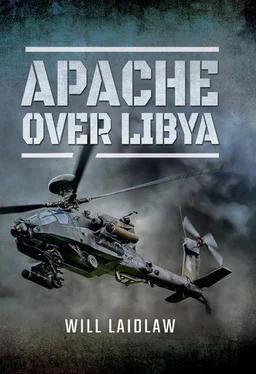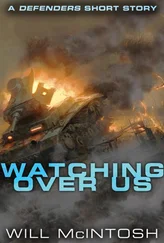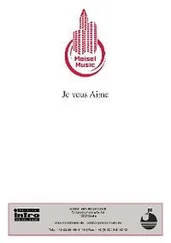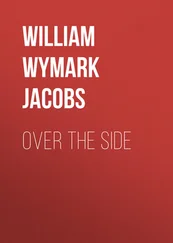UNSCR 1973 was passed on 17 March, and two days later a French jet destroyed a regime tank, thus beginning an intervention that would end with Gaddafi’s pitiless death, blown up, captured by a rampaging mob, sodomised with a bayonet and shot on 20 October. The NATO mission was called Operation Unified Protector. The British contribution was Operation Ellamy.
Enforcing a No Fly Zone was easy work. Once the regime’s air defence systems were taken down the jets could fly without threat. Targets were found, analysed and destroyed. The regime’s military were hit whenever they showed themselves and the siege continued. But Gaddafi had long been a survivor, and the regime adapted. They hid in hospitals and schools, knowing NATO would not strike there. Gaddafi’s soldiers did the same. They hid their armour, used technicals and travelled in buses. The rebels’ much wished-for breakthrough did not happen. They were ordinary citizens with guns; they had no military structure or tactics and they were being hammered by the regime. They were determined but disorganized, and thousands died as Gaddafi took his chance to extinguish the fires of revolt with as much force as he could muster.
Then stalemate took hold. The anticipation of April led to nothing, and May brought the rebels and NATO no closer to winning. Politicians looked around for what else they could throw at the problem, and we were chosen. An introductory mission near Brega, big media exposure and resolute words from Paris and London made us part of the campaign. We were there to cause problems, get in Gaddafi’s mind, prove NATO was willing to take risks and was unwavering. I was told to have a ‘cognitive effect’ on the regime by striking wherever NATO saw it best to use us, by making noise and menacing the regime, by taking down the targets others were unable to hit. And by not getting shot down.
Muammar’s seventh and youngest son, Khamis Gaddafi, was a career soldier. Schooled in the West and with military training in Russia, he was a genuine operator. His father had put him in charge of the elite 32 Brigade, based west of Tripoli at the Al Maya barracks. When the revolution began they mobilized to crush the resistance in Misrata, an easy task with their tonnes of heavy metal and thousands of shells. They lodged the 10,000-strong formation in the area of Zlitan, about 30 miles west of Misrata on the central coastal belt. Another 20 miles further west sits Al Khums, home to the Libyan Special Forces (SF). Khamis’ brigade was elite in its own right, and the pairing with the SF worked well. He had tanks, armoured fighting vehicles, artillery and technicals. And he had the very best anti-aircraft weapons. ZSU 23-4, SA-7, SA-7b, SA-18 and SA-24 were all part of his arsenal, and everyone was driving around in pickup trucks with a ZU-23 stuck on the back. The SF had fast boats and small-team patrols capable of getting behind the rebel front line and causing mayhem.
Together they surrounded and cut off Misrata in late February, then waited for the city to die. Their modus operandi was straightforward. They hid in farm buildings on the outskirts of the city. Periodically they would break cover, fire a barrage of artillery into the city and sneak back into hiding before NATO could find them. They blocked the roads, and anyone attempting to leave the city was arrested; when the jails filled up, regime snipers kept the population contained. At the same time the SF would dart up and down the coast, inserting patrols to sever rebel communications, kill them in their safe places and create the fear of being surrounded in a forlorn and helpless siege.
With fifty miles of depth to hide in, Khamis’ forces were well dispersed; there was no need to concentrate men on the front line where they would be vulnerable to both a rebel breakout and NATO jets. Misrata was being squeezed. Thousands lay injured in hospitals with scarce medical supplies. The Royal Navy halted any meaningful pro-Gad maritime operations, thus allowing a fragile opportunity to link with Benghazi. But this link was precarious and supplies were always well below the requirement. Overloaded ships would dock at night, often under artillery attack, offload rebels and equipment, load up with wounded and then head back to Benghazi. The slow, poorly coordinated sea lane was Misrata’s only lifeline, but it was not enough to keep the city from gradually, agonizingly, slipping into hell. Khamis had time on his side and he was steadily strangling the city. Day by day, barrage after barrage was edging Misrata towards defeat.
NATO kept up the air strikes and the Royal Navy patrolled the coastal zone, even lending gunfire on several occasions. But Khamis still looked strong. The rebels needed to take the fight to 32 Brigade and move the front line away from the city. If they could advance west Khamis would have fewer places to hide and NATO could find and strike them. If they moved the front line away from the city the siege would be lifted, supplies would move quicker, the wounded would get the help they needed and more rebels could join the fight. But time favoured Khamis. The longer the impasse continued the weaker NATO looked. At the same time Misrata was suffocating and Khamis was looking at a shiny new medal, higher rank and a bigger palace.
Chapter 7
The Zlitan Raids
The night after the first mission, 6,000 hours of flying skill in the hands of JB lined up the perfect Hellfire and Reuben Sands put it straight into a BM-21 multi-launch rocket system dug in next to a house outside Brega. NATO had considered the target three times before and rejected it as too risky due to the proximity of the building. Chris James had convinced them we could do it without damaging the building. When the Hellfire hit, the truck and weapons were destroyed, leaving the house untouched. The Targets people in Italy sat up. The Apache was now a compelling option in an air campaign that was at risk of stalling.
In the second week of June, after our two missions near Brega, Ocean lay 80 nautical miles north of Zlitan and 656 Squadron were planning to hit the command and control (C2) heart of the Khamis operation. Our part in the battle for Misrata was to disrupt Khamis where he thought he was safe and deny him the ability to move freely around Zlitan and Al Khums. The rebels could deal with the toe-to-toe fight on the front line, and we were going to create gaps for them exploit and push through. We knew Khamis was dangerous, but we had no idea he was ready and waiting to take us on.
At 6.00 p.m. local time on 8 June 2011 Sky News reported that HMS Ocean was off the coast of Misrata, ready to strike, and I had a security problem with big red attention-getters. Two unexpected strikes near Brega had kept pro-Gad guessing, but they were low-threat missions. Heading into the dark heart of 32 Brigade was a different proposition and I wanted as much surprise as I could get. With our location compromised, Khamis put his artillery away and sent his scouts and MANPAD teams to the coast. Pro-Gad was looking north, expecting the Apache. The following night, we went in.
Mission number three was simple enough – a C2 node made up of buildings and a radio mast. The target was coastal, but we would have to go feet-dry into the centre of 32 Brigade’s operation. John and I took mission lead, with Mark Hall and Charlie Tollbrooke, on their first mission, as wing. Running in against Khamis was about to give us our first brush with the most deadly anti-helicopter weapon on the modern battlefield.
With the target several miles from the low tide mark, we had to get into Libya first, turn on to an attack heading and then tip into the strike. We looked at the map and the satellite imagery and chose the uninhabited expanse of sand dunes five nautical miles north-east of Zlitan to go in feet-dry. No one would be there to hear us cross the coast and we could intercept our attack heading, get the missiles off and get away before Khamis had got his boots on. After that we would head east and take a look at a suspected vehicle checkpoint, rattle pro-Gad some more, then track out the 20 nautics for Mother.
Читать дальше












